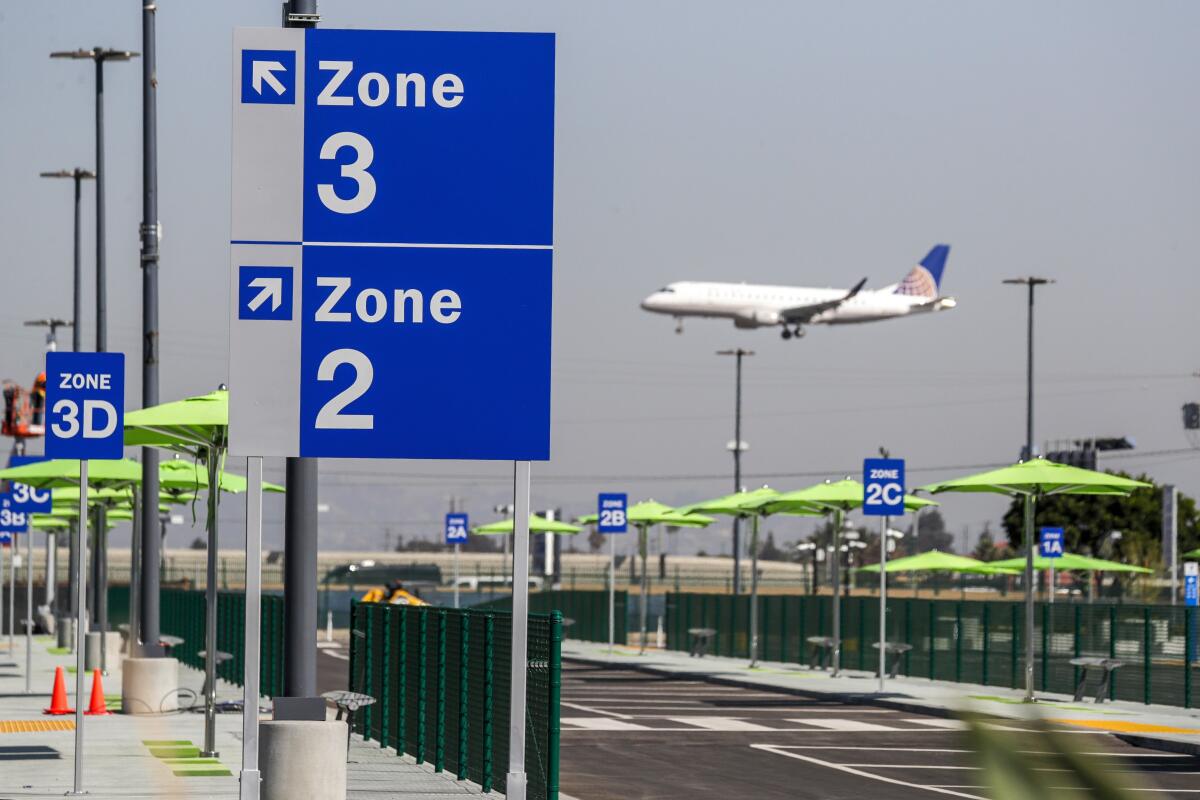LAX is a traffic-choked zoo. Banning ride-hailing pickups was the right move

- Share via
After traffic and smog, a favorite, familiar complaint about living in Los Angeles is the airport. Los Angeles International is consistently ranked among the worst airports for customer service and convenience, in part because of its horrendous congestion, confusing layout and shortage of good public transit options.
The hate was strong even before LAX embarked on a massive construction project, before a recent boom in air travel, and before thousands of Uber and Lyft vehicles were given permission in 2015 to pick up and drop off passengers at the airport. It’s always been hard to get to LAX. Now, driving through the horseshoe-shaped terminal can take half an hour, and airport officials warned it’s going to get worse as construction increases.
So Los Angeles World Airport officials changed their minds, and announced earlier this month that both ride-hailing services and taxis will be banned from picking up customers directly at LAX terminals at the end of the month. Instead, customers will need to walk or take a shuttle to a nearby parking lot that has been transformed into a pickup plaza, which the airport has named LAX-it (pronounced L-A-X-it, not laxit).
The plaza and the ban on ride-hailing and taxi pickups in the terminal will remain in effect until 2023, when the new elevated train, known as the people mover, is scheduled to open.
Needless to say, the announcement caused consternation. Travelers bemoaned the change, saying it was one more hassle at LAX. One letter writer to The Times even declared it was “the worst plan ever devised.”
Yes, it’s a change. Yes, it adds one more step to the process of leaving LAX. And, yes, it will probably be hardest on disabled travelers and those traveling with kids and lots of luggage who use ride-hailing services.
But it is a fair and temporary price to pay now for the greater goal: a modern airport that is actually easy to navigate and convenient for all travelers, and that is a credit to Los Angeles, not an embarrassment.
LAX is in the middle of a $14-billion capital improvement program, including building an entirely new concourse west of the Tom Bradley International Terminal and modernizing the existing terminals. The biggest change, with the greatest effect on travelers, will be the addition of the people mover.
The people-mover-to-light-rail connection should be the solution to one L.A.’s worst transportation mistakes: the city‘s failure two decades ago to build a rail line to LAX. When it’s completed, travelers to the airport will be able to take the Crenshaw Line to the new 96th Street and Aviation Boulevard station and connect to the people mover, which will whisk them between the terminals, a ground transportation hub and rental car facilities.
The people mover will run through the middle of the airport, with walkways connecting from the elevated stations to the terminals.
Ultimately, LAX will be a much easier place to navigate. But for the moment, the construction of a train through the center of the complex, on top of all the other work being done to the nation’s second-busiest commercial airport, means the already bad traffic will become even worse.
Moving ride-hailing and taxi pickups to the new lot will eliminate about 15% of the daily vehicle traffic in the terminal area. It should also make it easier for people arriving at LAX — including those being dropped off by an Uber, Lyft or taxi. Without the ban on pickups, airport officials project that on an average day during the summer, traffic would be as bad as it was on the worst day in 2017, which was the Sunday after Thanksgiving.
It’s also important to recognize that the arrival of Uber and Lyft has set off a significant shift in transportation at the airport. During the first half of 2019, LAX saw 10% more vehicle trips than in the same period in 2016, the first full year that Uber and Lyft operated at the airport, The Times reported. The ride-hailing companies now account for 27% of the vehicles in the terminal area every day. While rail-hailing trips have soared, the number of taxi trips fell by 39%, and ridership on high-occupancy buses and shuttles has also plummeted.
It’s clear that customers prefer the individual convenience of hailing a ride. But, even though it may be easier and sometimes cheaper to book an Uber or Lyft, all those extra car trips are worsening traffic and making LAX more congested and less convenient for everyone else.
In that way, LAX is a microcosm of our larger transportation challenges in Los Angeles, where people choose to drive because there aren’t enough good choices to get around. The job for LAX officials is to design a transportation system that makes it easier and more affordable to arrive and depart by rail, shuttle or other shared rides so that travelers and employees have good — or better — alternatives than taking a car to the airport. If LAX can do it, there’s hope for the rest of L.A.
More to Read
A cure for the common opinion
Get thought-provoking perspectives with our weekly newsletter.
You may occasionally receive promotional content from the Los Angeles Times.









